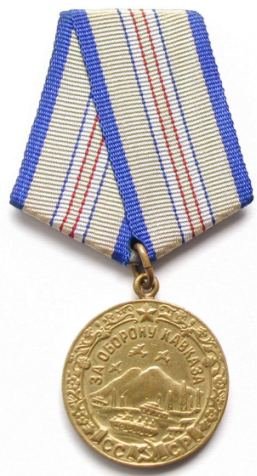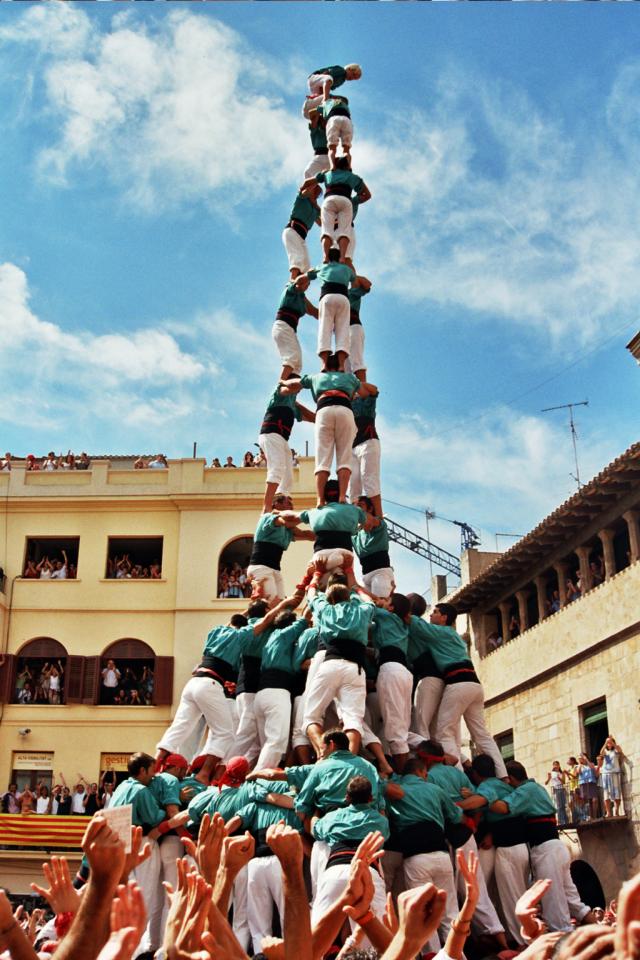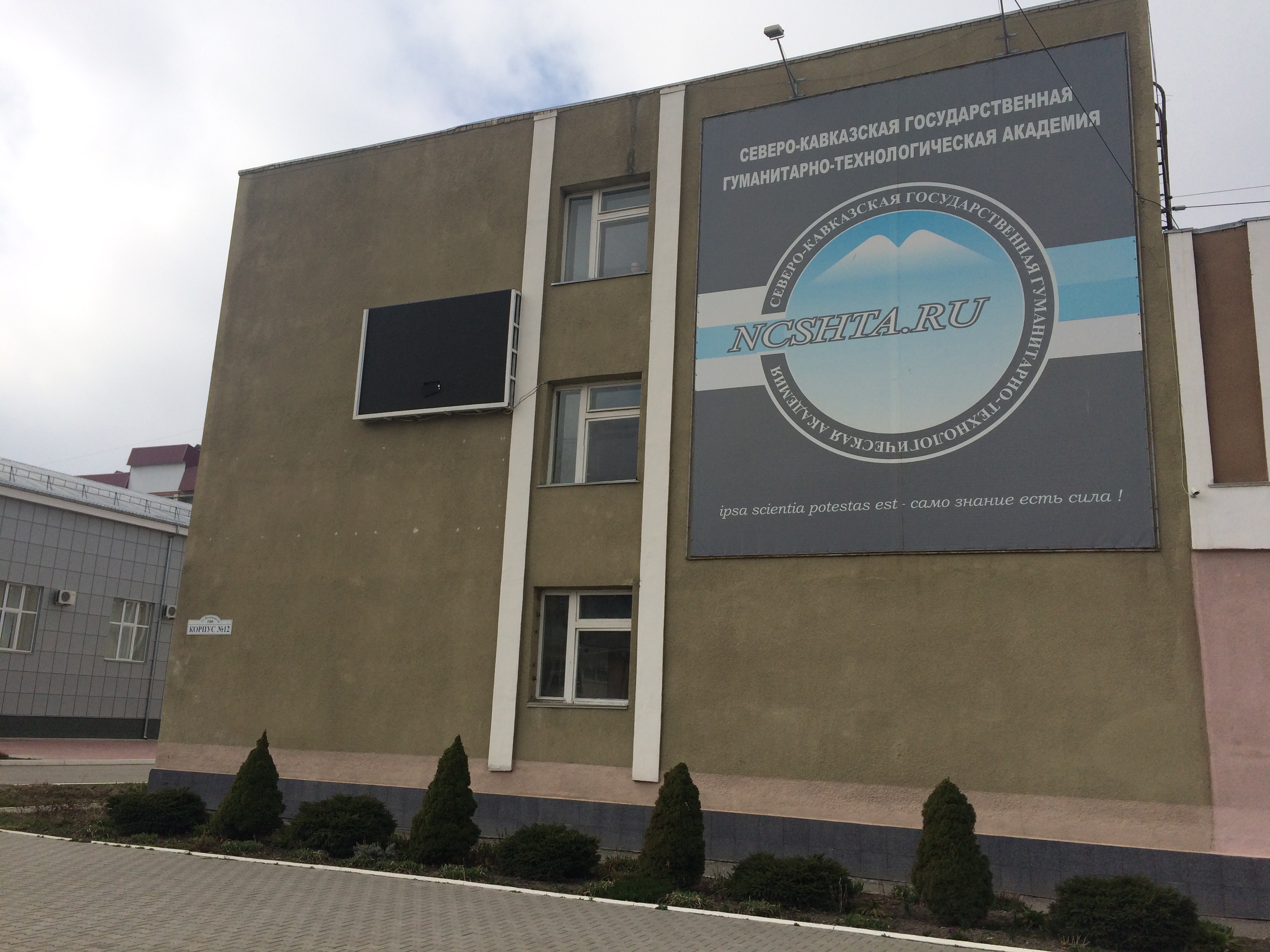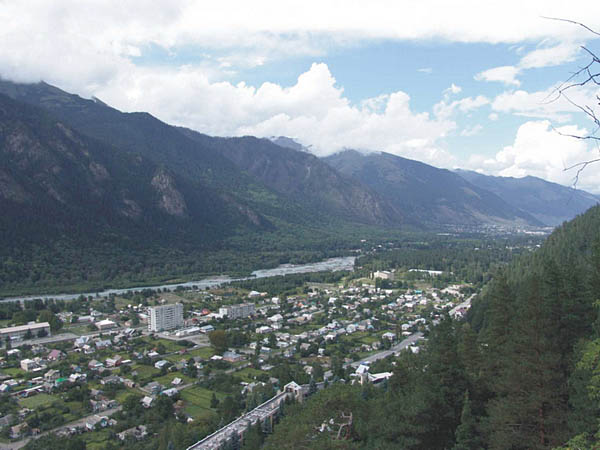|
Rescue Of Leningrad Jewish Children In Beslenei
The rescue of Leningrad Jewish children in Beslenei occurred in August, 1942, in aul of Beslenei, Cherkess Autonomous Oblast, Russian SFSR, USSR, when the local Circassian villagers adopted evacuated children from Leningrad orphanage, the most of whom were Jewish, and managed to forge documents with the purpose to prove Nazis that the children are of local descent. The orphanage, placed on the Malaya Okhta was evacuated in April, 1942 to Armavir by the Road of Life on the Ladoga's ice. However, in August German offensive reached Caucasus, and it was decided to evacuate the orphanage to Abkhazia via Teberda and Caucasus Range. When carts with weakened children entered Beslenei, 40 km west from Cherkessk, the locals, fearing that the children could not survive the transfer via the range, offered to adopt them, especially whom other villagers avoided to adopt due to possible punishment by the Nazis, i.e. Jews. The local selsoviet chairman Sagid Shovgenov and kolkhoz cha ... [...More Info...] [...Related Items...] OR: [Wikipedia] [Google] [Baidu] |
Beslenei
The Besleney ( Circassian: Bеслъэней, ; ) are one of the twelve major Circassian tribes, representing one of the twelve stars on the green-and-gold Circassian flag. By character, culture and language, the Besleney are closest to Kabardians. The noble families of the Besleney were Kanoko and Shaloho, ancestors of Kabardian Prince Beslan, (the son of legendary Prince Inal), who established his own tribe of the same name. Population The majority of the Besleney live in the valley of Bolshaya and Malaya Laba Rivers and on the bank of Urup in the Russian Republics of Karachay-Cherkessia, Krasnodar Krai and Adygea. They also extend to the valleys of Chetem, Fars, Psefir, Kuban (Western Circassia). Language The Besleney people speak the Besleney sub-dialect () of the Kabardian Adyghe dialect (East Circassian). However, because the Besleney tribe lived at the center of Circassia, the Besleney dialect also shares a large number of features with dialects of the West Adyg ... [...More Info...] [...Related Items...] OR: [Wikipedia] [Google] [Baidu] |
Battle Of Caucasus
The Battle of the Caucasus was a series of Axis and Soviet operations in the Caucasus as part of the Eastern Front of World War II. On 25 July 1942, German troops captured Rostov-on-Don, opening the Caucasus region of the southern Soviet Union to the Germans and threatening the oil fields beyond at Maikop, Grozny, and ultimately Baku. Two days prior, Adolf Hitler had issued a directive to launch an operation into the Caucasus named Operation Edelweiß. German units would reach their high water mark in the Caucasus in early November 1942, getting as far as the town of Alagir and city of Ordzhonikidze, some 610 km from their starting positions. Axis forces were compelled to withdraw from the area later that winter as Operation Little Saturn threatened to cut them off. Order of battle Red Army *North Caucasian Front – Marshal Semyon Budyonny (until September 1942) *Transcaucasian Front – General of the Army Ivan Tyulenev *Black Sea Fleet – Vice Admiral Filipp Oktyabrsk ... [...More Info...] [...Related Items...] OR: [Wikipedia] [Google] [Baidu] |
Stalingrad
Volgograd,. geographical renaming, formerly Tsaritsyn. (1589–1925) and Stalingrad. (1925–1961), is the largest city and the administrative centre of Volgograd Oblast, Russia. The city lies on the western bank of the Volga, covering an area of , with a population of slightly over one million residents. Volgograd is the List of cities and towns in Russia by population, 16th-largest city by population size in Russia, the third-largest city of the Southern Federal District, and the Volga#Biggest cities on the shores of the Volga, fourth-largest city on the Volga. The city was founded as the fortress of ''Tsaritsyn'' in 1589. By the 19th century, Tsaritsyn had become an important river-port and commercial centre, leading to its rapid population growth. In November 1917, at the start of the Russian Civil War, Tsaritsyn came under Bolshevik control. It fell briefly to the White Army in mid-1919 but Battle of Tsaritsyn, returned to Bolshevik control in January 1920. In 1925, the city ... [...More Info...] [...Related Items...] OR: [Wikipedia] [Google] [Baidu] |
Collaboration
Collaboration (from Latin ''com-'' "with" + ''laborare'' "to labor", "to work") is the process of two or more people, entities or organizations working together to complete a task or achieve a goal. Collaboration is similar to cooperation. The form of leadership can be social within a decentralized and egalitarian group.Spence, Muneera U. ''"Graphic Design: Collaborative Processes = Understanding Self and Others."'' (lecture) Art 325: Collaborative Processes. Fairbanks Hall, Oregon State University, Corvallis, Oregon. 13 April 2006See also. Teams that work collaboratively often access greater resources, recognition and rewards when facing competition for finite resources. Caroline S. Wagner and Loet Leydesdorff. Globalisation in the network of science in 2005: The diffusion of international collaboration and the formation of a core group.'' Structured methods of collaboration encourage introspection of behavior and communication. Such methods aim to increase the success of t ... [...More Info...] [...Related Items...] OR: [Wikipedia] [Google] [Baidu] |
Kolkhoz
A kolkhoz ( rus, колхо́з, a=ru-kolkhoz.ogg, p=kɐlˈxos) was a form of collective farm in the Soviet Union. Kolkhozes existed along with state farms or sovkhoz. These were the two components of the socialized farm sector that began to emerge in Agriculture in the Soviet Union, Soviet agriculture after the October Revolution of 1917, as an antithesis both to the feudalism, feudal structure of impoverished serfdom and aristocracy, aristocratic landlords and to individual or family farming. Initially, a collective farm resembled an updated version of the traditional Russian obshchina "commune", the generic "farming association" (''zemledel’cheskaya artel’''), the Association for Joint Cultivation of Land (TOZ), and finally the kolkhoz. This gradual shift to collective farming in the first 11 years after the October Revolution was turned into a "violent stampede" during the collectivization in the Soviet Union, forced collectivization campaign that began in 1928. Name T ... [...More Info...] [...Related Items...] OR: [Wikipedia] [Google] [Baidu] |
Selsoviet
A selsoviet (; , ; ) is the shortened name for Selsky soviet, i.e., rural council (; ; ). It has three closely related meanings: *The administration (''soviet (council), soviet'') of a certain rural area. *The territorial subdivision administered by such a council. *The building of the selsoviet administration. Selsoviets were the lowest level of administrative division in rural areas in the Soviet Union. After the dissolution of the Soviet Union, they were preserved as a third tier of administrative-territorial division throughout Ukraine, Belarus, and many of the federal subjects of Russia. A selsoviet is a rural administrative division of a raion (district) that includes one or several smaller rural localities and is in a subordination to its respective raion administration. The name refers to the local rural self-administration, the rural soviet (council), a part of the Soviet system of administration. The head of a selsoviet is called chairman, who had to be appointed by hi ... [...More Info...] [...Related Items...] OR: [Wikipedia] [Google] [Baidu] |
Cherkessk
Cherkessk (; Adyghe language, Adyghe: Шэрджэс къалэ; Kabardian language, Kabardian: Черкес-къалэ) is the capital city of Karachay-Cherkessia, Russia, as well as its political, economic, and cultural center. Population: 112,782 (2024). It was previously known as ''Batalpashinskaya'' (until 1931), ''Batalpashinsk'' (until 1934), ''Sulimov'' (until 1937), ''Yezhovo-Cherkessk'' (until 1939). Names In Russian, the city is called (''Čerkessk'') and has similar names in the languages of the city's other major ethnic groups. In Karachay language, Karachay, it is (''Çerkessk'') or (''Çerkessk şahar''); in Kabardian language, Kabardian, it is (''Şărdjăs qală'') or (''Čerkessk''); in Abaza language, Abaza, it is (''Čerkes q̇ala'') or (''Čerkessk''); in Nogai language, Nogai, it is (''Şerkeş şahar'') and in Chechen language, Chechen, it is (''Čerkessk''). For its first century of existence, Cherkessk was a ''stanitsa'', a village inside a C ... [...More Info...] [...Related Items...] OR: [Wikipedia] [Google] [Baidu] |
Caucasus Range
The Caucasus Mountains * * Azerbaijani: , * * * * * * * * * * * is a mountain range at the intersection of Asia and Europe. Stretching between the Black Sea and the Caspian Sea, they are surrounded by the Caucasus region and are home to Mount Elbrus, the highest peak in Europe at above sea level. The Caucasus Mountains include the Greater Caucasus in the north and the Lesser Caucasus in the south. The Greater Caucasus runs west-northwest to east-southeast, from the Western Caucasus on the northeastern shore of the Black Sea to close to Baku on the Caspian Sea, in Azerbaijan. The Lesser Caucasus runs parallel to the Greater about south. The Greater and Lesser Caucasus ranges are connected by the Likhi Range, and to the west and east of the Likhi Range lie the Colchis Plain and the Kur-Araz Lowland respectively. The Meskheti Range is a part of the Lesser Caucasus system. In the southeast, the Aras River separates the Lesser Caucasus from the Talysh Mount ... [...More Info...] [...Related Items...] OR: [Wikipedia] [Google] [Baidu] |
Teberda
Teberda (, , ''Teberdi'') is a town under the administrative jurisdiction of the town of republic significance of Karachayevsk in the Karachay–Cherkess Republic, Russia, located in the Caucasus Mountains south of Cherkessk at the elevation of about . Population: The Teberda River flows through the town. It is the gateway to the Teberda Nature Reserve, an area is known for its natural environment and hiking trails. History It was founded in 1868 as a Karachay settlement, and was originally called Baychoralany-Kyabak. Town status was granted to it in 1971. During WWII, in 1942, hundreds of local Jews were murdered in mass executions perpetrated by Germans. From 1944 till 1957 Teberda was part of Georgian Soviet Socialist Republic. Demographics In 2002, the population included: *Karachays (64.0%) *Russians (29.1%) *Ossetians The Ossetians ( or ; ),Merriam-Webster (2021), s.v"Ossete" also known as Ossetes ( ), Ossets ( ), and Alans ( ), are an Iranian peoples, Iranian ... [...More Info...] [...Related Items...] OR: [Wikipedia] [Google] [Baidu] |
Abkhazia
Abkhazia, officially the Republic of Abkhazia, is a List of states with limited recognition, partially recognised state in the South Caucasus, on the eastern coast of the Black Sea, at the intersection of Eastern Europe and West Asia. It covers and has a population of around 245,000. Its capital and largest city is Sukhumi. The political status of Abkhazia is a central issue of the Abkhazia conflict and Georgia–Russia relations. Abkhazia has been International recognition of Abkhazia and South Ossetia, recognised as an independent state only by 5 states: Russia, Venezuela, Nicaragua, Nauru, and Syria. Georgia (country), Georgia and other countries consider Abkhazia as a Georgia's sovereign territory.Olga Oliker, Thomas S. Szayna. Faultlines of Conflict in Central Asia and the South Caucasus: Implications for the U.S. Army. Rand Corporation, 2003, .Emmanuel Karagiannis. Energy and Security in the Caucasus. Routledge, 2002. . Lacking effective control over the Abkhazian territ ... [...More Info...] [...Related Items...] OR: [Wikipedia] [Google] [Baidu] |
Lake Ladoga
Lake Ladoga is a freshwater lake located in the Republic of Karelia and Leningrad Oblast in northwestern Russia, in the vicinity of Saint Petersburg. It is the largest lake located entirely in Europe, the second largest lake in Russia after Lake Baikal, and the List of lakes by area, 14th largest freshwater lake by area in the world. It is comparable in size to Lake Ontario. ''Ladoga Lacus'', a methane lake on Saturn's moon Titan (moon), Titan, is named after the lake. Etymology In one of Nestor the Chronicler, Nestor's chronicles from the 12th century a lake called "the Great Nevo" is mentioned, a clear link to the Neva River and possibly further to Finnish language, Finnish ''nevo'' 'sea' or ''neva'' 'bog, quagmire'.:ru:Поспелов, Евгений Михайлович, Evgeny Pospelov: ''Geographical names of the world. Toponymic dictionary.'' Second edition. Astrel, Moscow 2001, pp. 106f. Ancient Norse sagas and Hanseatic treaties both mention a city made of lakes named ... [...More Info...] [...Related Items...] OR: [Wikipedia] [Google] [Baidu] |
Cherkess Autonomous Oblast
The Cherkess Autonomous Oblast (; , ''Čérkés avtonomne oblast’'') or Cherkessia (; , ''Šerdžes'', or , ''Čérkés xekw'') was an autonomous oblast of the Russian SFSR, Soviet Union The Union of Soviet Socialist Republics. (USSR), commonly known as the Soviet Union, was a List of former transcontinental countries#Since 1700, transcontinental country that spanned much of Eurasia from 1922 until Dissolution of the Soviet ..., created on April 26, 1926, by the split of the Karachay-Cherkess Autonomous Oblast. It was called the Cherkess National Okrug () until April 30, 1928. It was dissolved in 1957 by the creation of the new Karachay-Cherkess Autonomous Oblast. ;Territorial changes of the Cherkess Autonomous Oblast File:Karach-and-Circ- aut-reg1928.png, 1928 File:Circassian and Karachay Autonomous Region.png, 1934 File:Karachay.JPG, 1943 File:Circassian Autonomous Region1950.png, 1950 References {{Use mdy dates, date=April 2017 1926 establis ... [...More Info...] [...Related Items...] OR: [Wikipedia] [Google] [Baidu] |








